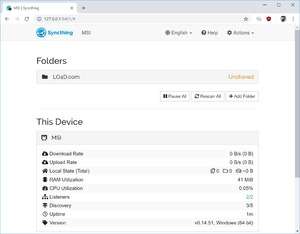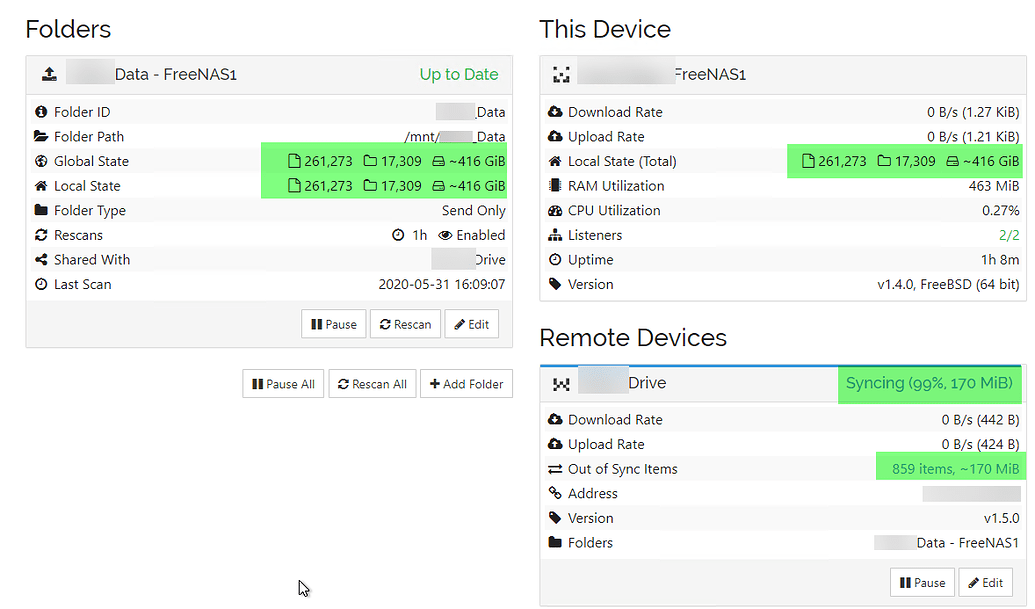

- #Syncthing file versioning how to#
- #Syncthing file versioning mac os#
- #Syncthing file versioning install#
- #Syncthing file versioning archive#
- #Syncthing file versioning for android#
NOTE: You will need to repeat these same installation steps on the other server. If you got similar output, then Syncthing is installed successfully. Verify installation by checking the Syncthing version: syncthing -version
#Syncthing file versioning install#
Once done, update system packages one more time, and install Syncthing package: apt-get update Install all dependencies with the following command: apt-get install gnupg2 curl apt-transport-httpsĪdd and download the release key: curl -s | apt-key add -Īdd the Syncthing repository to APT with the following command: echo "deb syncthing release" > /etc/apt//syncthing.list Following the steps to install to add Syncthing repo and install it on Ubuntu.įirst, update the system packages with the following command: apt update Syncthing is available on the official repository.
#Syncthing file versioning how to#
In this tutorial, we learn how to install Syncthing on Ubuntu 20.04.
#Syncthing file versioning mac os#
Cross-platform avaliable on: Linux, Android, Unix, Solaris, Windows and Mac OS X.All data transmission between multiple devices is safe and encrypted with TLS.

Syncthing can be used to keep files and directories synchronized in real-time. It uses a peer-to-peer architecture and continuous file synchronization exchanges data directly between devices in a fully automated way. Have you tried Syncthing yet? If yes, how was your experience with it? Feel free to share it in the comments below.Īlso, if you know about some awesome alternatives to this – let me know about it as well.Syncthing is a free and open-source program to sync files between devices from a local network or remote devices over the internet. Overall, it works quite well – but I must say that you shouldn’t rely on it as the only backup solution to your data. Technically, it uses the resources of your system to work – so if you have a number of devices connected to sync, it should potentially improve the sync speed (upload/download). Or, did I miss the option? Let me know in the comments if I did. So, if we could have an option to explicitly force sync, that could help. However, when I tried syncing it to a phone (Android) – the sync started a bit late, it wasn’t very quick. I tried syncing folders, removing them, adding duplicate files to see how the file versioning works, and so on.

Personally, I got it installed on Pop!_OS 19.10 and used it for a while before writing this up. You can also utilize the terminal to get it installed if you have a Debian-based distro – the instructions are on the official download page.
#Syncthing file versioning for android#
You’ll find several other options for Android as well. In addition to that, there are solid authentication methods to ensure that only the devices/connections you allow explicitly will be granted access to sync/read data.įor Android smartphones, you can also force the traffic through Tor if you’re using the Orbot app. So, Syncthing makes sure the communication is secured using TLS.

Security & PrivacyĮven though you do not share your data with any cloud service providers, there are still some connections made that might gain the attention of an eavesdropper. However, it does let you configure advanced settings when needed. While being a peer-to-peer file synchronization tool, it just works out of the box with no advanced tweaks. But, when you create a folder to sync, that’s when you will find the option to toggle the file versioning to your preferred method.
#Syncthing file versioning archive#
Syncthing utilizes a variety of File Versioning methods to archive the old files if they are replaced or deleted.īy default, you won’t find it enabled. Here, I’ll highlight a few useful features of Syncthing: Cross-Platform Support Syncthing is indeed quite simple and easy to understand – even though it is recommended that you should go through the documentation if you want to use every bit of its functionality. You probably do not want a lot of options in a synchronization tool – it should be dead simple to work reliably to sync your files. I’d also recommend reading the official FAQ to clear some confusion on how it works – if you’re interested. Technically, you can have your important files accessible on multiple systems securely and privately without worrying about anyone spying on your data.įor instance, you may not want to store some of the sensitive files on the cloud – so you can add other trusted devices to sync and keep a copy of those files.Įven though I described it briefly, there’s more to it and than meets the eye. All things considered, Syncthing can come in handy for a lot of things.


 0 kommentar(er)
0 kommentar(er)
